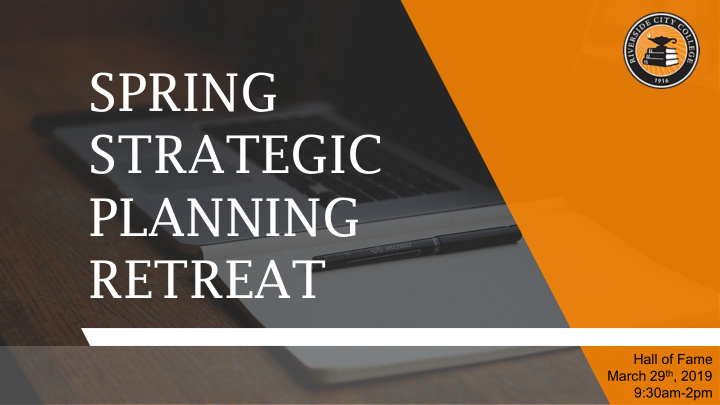



SPRING STRATEGIC PLANNING RETREAT Hall of Fame March 29 th , 2019 9:30am-2pm
2 AGENDA ▸ Welcome ▸ Retreat Objectives ▸ Accreditation Reflection, Update, and Activity ▸ Accreditation QFE: Pillar 4 Alignment ▸ Teaching and Learning at RCC: Core Values and SWOT Analysis
3 RETREAT OBJECTIVES 2. Pillar 4 visioning and SWOT 1. Build awareness of what the analysis to guide the QFE college community has discovered Guided Pathways Pillar 4 so far in each standard and reflect project on how the standards function within and how well they are aligned to college structures, processes, and ongoing work
4 ACCREDITATION Reflecting on what has been discovered in working on each standard
5 OUTCOMES 1. Understand what work has been completed on the accreditation standards so far 2. Know the steps and processes for upcoming activities 3. Be aware of Quality Focus Essay topics and the various components of the QFE
6 STANDARDS AND COUNCILS
7 PROGRESS ON THE STANDARDS
8 STANDARD REVIEW PROCESS
9 QUESTIONS GUIDING the REVIEW
10 STANDARD I REVIEW HIGHLIGHTS
11 What word or phrase comes to mind when you think about QUALITY?
12
13 QUALITY FOCUS ESSAY (QFE)
14 QFE STRUCTURE
15 QFE PROJECT 1: PROGRAM MAPS AND DEGREE PROFILES
16 QFE PROJECT 2: INTEGRATED ACADEMIC SUPPORT
17 QFE PROJECT 3: TEACHING AND LEARNING STRATEGIES To be guided by the discussion at today’s retreat !
18 ACCREDITATION STANDARDS ACTIVITY
ACCREDITATION ACTIVITY
20 BREAK 10 MINUTES
21 ACCREDITATION QFE: PILLAR 4
22 RECAP ON THE QFE The QFE details what the College would like to accomplish and how it plans to get there in regards to Student Learning and Achievement. ▸ Aspirational, but still realistic and culminate in observable and measurable outcomes ▸ Already in compliance, but would like to do more and be better
WHAT IS PILLAR 4? 23 Ensure Learning ▸ The goal is to enrich and strengthen student learning primarily through classroom instruction.
24 PILLAR 4: ESSENTIAL PRACTICES A. Program learning outcomes are aligned with requirements for success in further education and employment targeted by each program B. Instruction across programs (especially in program introductory courses) engages students in active and applied learning, encouraging them to think critically, solve meaningful problems, and work and communicate effectively with others.
25 PILLAR 4: ESSENTIAL PRACTICES C. Students have ample opportunity to apply and deepen knowledge and skills through projects, internships, co-ops, clinical placements, group projects outside of class, service learning, study abroad and other experiential learning activities that program faculty intentionally embed into coursework. D. Faculty/programs assess whether students are mastering learning outcomes and building skills across each program, in both arts and sciences and career/technical programs.
26 PILLAR 4: ESSENTIAL PRACTICES E. Results of learning outcomes assessments are used to improve teaching and learning through program review, professional development, and other intentional campus efforts. F. The college helps students document their learning for employers and universities through portfolios and other means beyond transcripts. G. The college assesses effectiveness of educational practice (e.g. using CCSSE or SENSE, etc.) and uses results to create targeted professional development
27 PROGRESS TO DATE ON PILLAR 4 AT RCC PLO assessment, Program College GE SLO’s Internships / Review and assessment, and apprentice- Planning general education ships offerings with through CTE ADT’s Student Equity Faculty focused pedagogy, Professional Disaggregated student Development student equity engagement, and course contextualized success data learning
28 HOW DO WE ENSURE THAT ALL STUDENTS ARE LEARNING ? H ow is the college ensuring What opportunities exist for faculty or advisors to critically examine their role in that underrepresented advancing equity-minded teaching and students participate in advising practices at the college (e.g., program-relevant active and critically examining the role of unconscious bias in the classroom or experiential learning advising that could affect student opportunities? aspirations for a particular field and/or program selection)? CONSIDERATIONS FOCUSING Is the college disaggregating program As faculty make curricular changes to ON PILLAR 4 learning outcomes data, program retention better align course assignments with and completion data, and other assessment program learning outcomes, how does the measures by race, income, age, and college support faculty to implement gender to examine equity gaps? How is pedagogical changes that better support this data disseminated and discuss among learning outcomes success for college staff, with students, and with the underrepresented students (e.g., culturally outside community? responsive teaching)?
29 LUNCH BREAK 30 MINUTES
30 TEACHING & LEARNING AT RIVERSIDE CITY COLLEGE
31 ACTIVITY 1 VISIONING TEACHING & LEARNING PRINCIPLES ACTIVITY
32 ACTIVITY 2 TEACHING & LEARNING SWOT ANALYSIS Activity
33 OUR PROCESS IS KEY: WHAT IS NEXT? NEXT and TIMELINE STEPS 1. Activity documents will be handed to Professional Development, Equity and TLLC to provide preliminary recommendations by May 2. Recommendations from Committees will be utilized to guide the QFE work and will be embedded into the Strategic Planning work for the 19-20 year
34 ASSESSMENT OF TODAY’S WORK https://www.surveymonkey.com/r/RCCSpring19Retreat Your Feedback is Appreciated! Please take a few moments to fill out the survey
35 THANKS! Any questions?
Recommend
More recommend